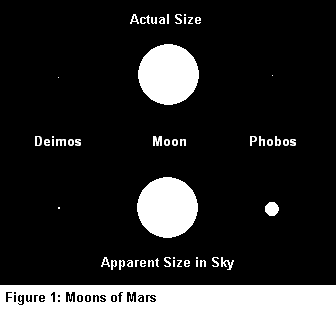

Ever since I was about ten years old, I liked observing the moon, and liked watching it progress through its phases throughout the month, especially once I understood why it did so. But ever since I really took an interest in astronomy when I was a teenager, I often wondered why we have only one moon, while many of the other planets in our solar system have several moons orbiting them. What if we had more than one moon? “That would be pretty cool, to see several moons in the night sky,” I thought. What a sight it would be to see the night sky as it might be seen on Jupiter, Saturn, or Uranus! Can you imagine seeing so many prominent objects in the night sky? I know those of you who relish the dark, moonless nights for observing galaxies and nebulae are cursing me for making such a statement, because it would be a rare occasion indeed to have a moonless night on one of those planets.
Well, that idea got me thinking. Would the other moons really appear as large and prominent as our own? I’ve seen tables showing the diameters of the various moons of our solar system, which give a great comparison of the size of them compared to our own moon. Ours is one of the larger moons in the solar system, but certainly not the largest. But these tables don’t give any idea of how these moons would appear in the sky as viewed from the respective planets they orbit, or how they would compare to the apparent size of our moon in the Earth’s sky. Would the largest moons appear small in the sky or the smaller moons appear large? The moon tables usually also gave the distances of the moons from the planets they orbit. I thought, “This information, along with a bit of my high school trigonometry should give me an idea.”
In my first draft of this article, I had compared the apparent size of a given moon to that of our own, without really defining “size”. I then realized that some who may read this would consider “size” to mean diameter, while others would consider it to mean area. Therefore, I included both comparisons for each given moon.
We’ll begin at home with our own moon. With a diameter of 3,476 km (2,160 mi) and an average distance from us of 384,400 km (238,850 mi), it spans 31.1 arc minutes, or just over 1/2° in the night sky at its largest (full phase).
When I was a teenager, I also had wondered why we can’t see the moons of our closest neighboring planet. After all, we can easily see the Galilean moons of Jupiter with a good pair of binoculars, and they’re much further away from us than the moons of Mars. After discovering those moon tables many years ago, I realized that the moons of Mars are both too small, and too close to the planet to be seen from Earth, at least with any equipment I would likely ever own. But what would they look like from the Martian surface? At 7.4 arc minutes, Phobos would appear about 1/4 of the diameter (6% of the area) in the Martian sky as our moon appears in our sky. At 1.2 arc minutes, Deimos would merely look like a bright star, about twice the diameter of Jupiter in our sky. A visual comparison of the moons’ actual size versus the apparent size in the sky as viewed from their respective planets is shown in Figure 1.

Since the Galilean moons of Jupiter are so large that they can easily be seen with a good pair of binoculars, I figured that they must be massive in the Jovian sky. However, this is not the case. Io would appear as the largest moon in the Jovian sky, which would be slightly smaller than our moon appears in our sky. Europa and Ganymede would each appear about half of the diameter (1/4 of the area) of our moon, and Callisto would appear about 1/4 of the diameter (6% of the area) as our moon. A visual comparison of the moons’ actual size versus the apparent size in the sky as viewed from their respective planets is shown in Figure 2.
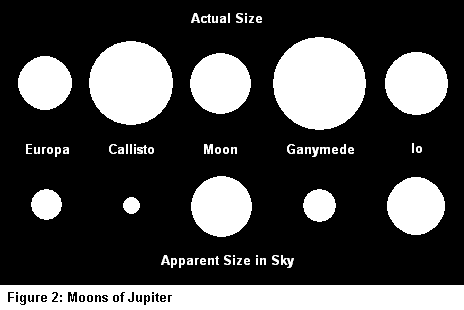
Saturn is the planet with the greatest number of significant moons, which also have the greatest variation of apparent sizes in the night sky. Titan is Saturn’s largest moon, and also happens to appear the largest in the Saturnian sky at slightly less than half the diameter (1/4 of the area) of our moon in our sky. Next is Tethys, which appears a bit smaller than Titan. Dione and Rhea both appear about 1/3 of the diameter (11% of the area) of our moon. Enceladus and Mimas are next, appearing about 1/4 of the diameter (6% of the area) of our moon. The remaining three moons, Hyperion, Iapetus, and Phoebe, would appear as no more than stars in the Saturnian sky. Hyperion and Iapetus at 0.5 and 1.4 arc minutes respectively, would be fairly bright, while Phoebe at less than 4 arc seconds, would be much smaller and fainter. A visual comparison of the moons’ actual size versus the apparent size in the sky as viewed from their respective planets is shown in Figure 3.
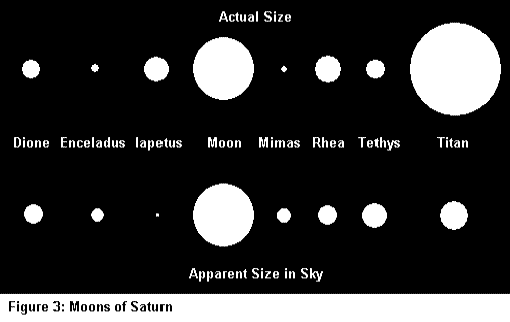
The moons of Uranus seem to appear closer together in size in the Uranian sky than the other planets’ moons. The largest would be Ariel at 2/3 of the diameter (44% of the area) of our moon in our sky, then Umbriel at 1/2 of the diameter (1/4 of the area) of our moon. Miranda and Titania would appear the same diameter in the Uranian sky at 40% of the diameter (16% of the area) of our moon in our sky. Oberon is the largest moon of Uranus, but it would appear as the smallest in the Uranian sky at a little less than 1/3 of the diameter (11% of the area) of our moon in our sky. A visual comparison of the moons’ actual size versus the apparent size in the sky as viewed from their respective planets is shown in Figure 4.
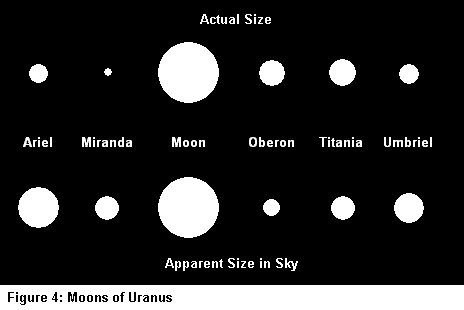
Neptune’s largest moon, Triton, would also appear as one of the larger moons at about 84% of the diameter (71% of the area) of our moon in our sky. Nereid would merely appear as a bright star in the Neptunian sky. A visual comparison of the moons’ actual size versus the apparent size in the sky as viewed from their respective planets is shown in Figure 5.
Neptune is the last planet that I will cover in this article, since Pluto is no longer considered to be a real planet. Actually, that’s not really why, especially since I think Pluto should retain its planet status because it has been considered a planet for over 75 years now. The real reason is because Pluto and Charon really behave more like a binary planet system because they are closer in size to each other, as well as closer to each other than most moons are to the planets which they orbit. A summary of the moons’ sizes, distances, actual sizes, and apparent sizes is shown in table 1 below, for those of you who just have to have the numerical data.
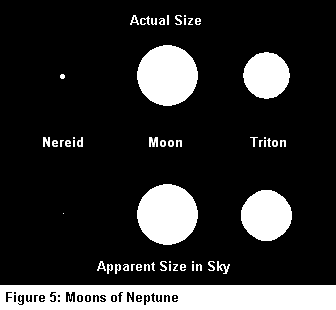
| Planet | Moon | Distance from Planet (km) |
Distance from Planet (mi) |
Diameter (km) | Diameter (mi) | Apparent Size in Sky (arc min)1 |
Relative Diameter2 | Relative Area3 |
|---|---|---|---|---|---|---|---|---|
| Earth | Moon | 384,000 | 238,850 | 3,476 | 2,160 | 31.1 | 100% | 100% |
| Mars | Phobos | 23,460 | 14,577 | 8 | 5 | 1.2 | 3.8% | 0.1% |
| Deimos | 9,270 | 5,760 | 20 | 12 | 7.4 | 24% | 5.7% | |
| Jupiter | Callisto | 1,883,000 | 1,170,045 | 4,800 | 2,983 | 8.8 | 28% | 7.9% |
| Europa | 670,900 | 416,879 | 3,126 | 1,942 | 16.0 | 52% | 27% | |
| Ganymede | 1,070,000 | 664,869 | 5,276 | 3,278 | 17.0 | 55% | 30% | |
| Io | 421,600 | 261,971 | 3,629 | 2,255 | 29.6 | 95% | 91% | |
| Saturn | Dione | 377,400 | 234,506 | 1,120 | 696 | 10.2 | 33% | 11% |
| Enceladus | 238,020 | 147,899 | 498 | 309 | 7.2 | 23% | 5.4% | |
| Hyperion | 1,481,000 | 920,253 | 226 | 140 | 0.52 | 1.7% | <0.1% | |
| Iapetus | 3,561,300 | 2,212,895 | 1,436 | 892 | 1.4 | 4.5% | 0.2% | |
| Mimas | 185,520 | 115,277 | 398 | 247 | 7.4 | 24% | 5.6% | |
| Phoebe | 12,952,000 | 8,048,020 | 220 | 137 | 0.06 | 0.2% | <0.1% | |
| Rhea | 527,040 | 327,488 | 1,528 | 949 | 10.0 | 32% | 10% | |
| Tethys | 294,660 | 183,094 | 1,060 | 659 | 12.4 | 40% | 16% | |
| Titan | 1,221,850 | 759,224 | 5,150 | 3,200 | 14.5 | 47% | 22% | |
| Uranus | Ariel | 191,240 | 118,831 | 1,160 | 721 | 20.9 | 67% | 45% |
| Miranda | 129,780 | 80,642 | 472 | 293 | 12.5 | 40% | 16% | |
| Oberon | 582,600 | 362,012 | 1,526 | 948 | 9.0 | 29% | 8.4% | |
| Titania | 435,840 | 270,819 | 1,580 | 982 | 12.5 | 40% | 16% | |
| Umbriel | 265,970 | 165,267 | 1,190 | 739 | 15.4 | 50% | 25% | |
| Neptune | Nereid | 5,513,400 | 3,425,876 | 340 | 211 | 0.21 | 0.7% | <0.1% |
| Triton | 354,800 | 220,463 | 2,705 | 1,681 | 26.2 | 84% | 71% |
1) Relative size in arc seconds as observed from the respective planet.
2) Ratio of diameter relative to our moon as viewed from Earth.
3) Ratio of area relative to our moon as viewed from Earth.